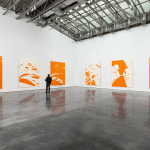Earl Cunningham (1893 – 1977), a prolific landscape artist who worked from memory, is considered a “folk modernist” whose work conveys some of the complex meanings about the nature of American life. In the NYTimes, Karen Rosenberg writes that Cunningham’s style may have been childlike, but he was hardly na�ve. “He was well aware of the ‘discovery’ of folk art during the Depression (he is known to have clipped news articles about Grandma Moses) and marketed himself accordingly. He signed one of his paintings ‘Earl Cunningham, American Primitive’ and printed business cards with the label ‘primitive artist.’ Later he exhibited his works in his St. Augustine curio shop but with a sign that read, ‘These paintings are not for sale.’ Marilyn Mennello, Cunningham�s most devoted collector, recalled that when she first tried to purchase a painting, his response was, ‘Someone is going to come �round here and buy all my paintings at one time for $40,000.’ He seemed to be holding out for the big payday, although his lifestyle suggested that fame on the level of Grandma Moses was more of an incentive than money.” Read more.
“Earl Cunningham’s America,” curated by Virginia Mecklenburg. American Folk Art Museum, New York, NY. Through August 31.
Related posts:
Earl Cunningham’s imaginary landscapes
×























Still waitin for that guy here.